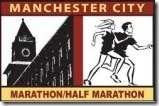 Last Sunday I ran the Manchester City Marathon, my second and final marathon of the Fall racing season. The 5 weeks between earning my BQ at Smuttynose and my running of this race were both crazily busy and exhausting, and my motivation to train for the race in Manchester was sorely lacking. I did put in miles, but most were uninspired. I’d attribute my slack training to a combination of fatigue, mental letdown from completion of the Smuttynose race, and just a general need to let my body take a break. On top of this, the course in Manchester is extremely hilly, and I knew there was no way a PR would be in play. Thus, I entertained for a moment the idea of either dropping out of the race or scaling back and just doing the half marathon. However, it’s not in my nature to back out of something I committed to, so when a local running friend, Ron of the Got Lactate! blog, suggested I join him in pacing the 3:40 finish group, I saw this as the ideal way to run the race – spend some time running with people I knew, and try to help others meet their time goal since mine was taken care of last month.
Last Sunday I ran the Manchester City Marathon, my second and final marathon of the Fall racing season. The 5 weeks between earning my BQ at Smuttynose and my running of this race were both crazily busy and exhausting, and my motivation to train for the race in Manchester was sorely lacking. I did put in miles, but most were uninspired. I’d attribute my slack training to a combination of fatigue, mental letdown from completion of the Smuttynose race, and just a general need to let my body take a break. On top of this, the course in Manchester is extremely hilly, and I knew there was no way a PR would be in play. Thus, I entertained for a moment the idea of either dropping out of the race or scaling back and just doing the half marathon. However, it’s not in my nature to back out of something I committed to, so when a local running friend, Ron of the Got Lactate! blog, suggested I join him in pacing the 3:40 finish group, I saw this as the ideal way to run the race – spend some time running with people I knew, and try to help others meet their time goal since mine was taken care of last month.
Rather than do a blow-by-blow report of the marathon, I’m going to take a different approach here and just try to summarize some of the key points.
1. Pacing was a blast. I had a great time running at a conversational pace with friends and strangers alike. We had a large group with us for much of the first half of the race, but after the half-marathoners split off at about the 13 mile mark, our group got considerably smaller. Then, by the time we finished the killer climb up Daniel Plummer Road at mile 18 (which knocked me out last year) and ran through the Saint Anselm College campus where I work, our group began to fragment even more, and eventually there were only about 6-7 of us left, most of whom had qualified for Boston in a race earlier in the Fall and were running more-or-less for fun. I spent most of the final six miles running with my two fellow pacers (Ron and Joe), and two guys in sport kilts that had been with us for most of the race. I actually crossed the finish line simultaneously with Joe and the two kilted runners – it was great to finish the race with them since we spent most of it running either together or leapfrogging one another, and it’s a finish-line photo that I can’t wait to see.
My official finish time was 3:39:36. Although I didn’t manage to help get anyone to the finish line who was specifically shooting for the 3:40 time as a goal, it felt good nonetheless to fulfill the duty of a pacer and finish just under the target time.
Elevation profile for the Manchester City Marathon
2. The race hurt! It seems strange that a race run considerably slower than the one I ran just a month could hurt more, but that’s the way things panned out. As I said above, Manchester is a very hard course with a lot of elevation change (see elevation profile above), and I had not done a lot of hill training prior to Smuttynose since it was a relatively flat course. On top of that, I don’t think my body was fully recovered from Smuttynose, nor was it fully recovered from a hard 15 miler that I had run the weekend before to see if my feet could handle marathon distance in the Saucony Grid Type A4 racing flats (more on this below). I was feeling sore in both my feet and legs very early in the race, particularly on the left side, and I threw out any attempt to pay attention to form very early as a result – I opted to just let my body find the way to run that hurt the least. I think the soreness led to some odd gait alteration on the left, and by late race my left ITB and hip flexor were both barking at me loudly. Running the big downhill in mile 20 was brutal on my quads, and I don’t think I have ever been that sore in a marathon before (well, maybe in this same race last year). Today, three days removed from the race, everything feels mostly fine except my feet, where it seems I have some residual soreness under the lateral forefoot. The plan is to take at least a full week off just to give my body a chance to rest now that my marathons are out of the way.
Mile splits from my running of the Manchester City Marathon
3. I didn’t hit the wall. Manchester was the third consecutive marathon in which I did not hit the wall. In fact, in Manchester the only thing holding me back was the soreness and tightness in my legs. Despite the latter, we managed fairly even splits (see split chart above), which is impressive when looking at what happened to most people’s pace in the final 5.2 miles of the race.
A big positive that came out of Manchester is that I think I have finally nailed my fueling strategy – bagel with cream cheese, Odwalla Mango Tango, and coffee for breakfast, Powerbar just before the race, and about six gels during the race. For this race I used two Hydrapak Soft Flasks (these things are awesome!), each filled with three Hammer gels and diluted with water. This was the first time I had used Hammer gels, and unlike my GU experience at Smuttynose, I was very impressed. I went with Orange flavored gel in one flask, and Apple Cinnamon in the other, and both tasted great. I also added in one Double Espresso Hammer Gel (from the packet) at the midway point with the caffeine boost. I was mentally clear-headed throughout the race, and never felt like my aerobic conditioning was being taxed – it was just those darned legs that wouldn’t cooperate.
4. I wore too little shoe. My original plan after Smuttynose was to try and work myself up to the point of being able to run the Manchester City Marathon in my Vibram Fivefingers Bikilas. However, I had forgotten how much running a marathon takes out of me, and my training didn’t get back in gear sufficiently fast enough to achieve this. I made it to a 10 mile long run in my Trek Sports, and came to the realization that trying to run 26.2 miles in the Vibrams was downright foolish, and that I would simply be asking for an injury if I did so.
Saucony Grid Type A4 Racing Flat
As a compromise, I chose to do something that was perhaps equally foolish – I chose to run the race in a shoe that I had only run in twice – the Saucony Grid Type A4 (see picture above). As I mentioned above, my second run in the Grid Type A4 was a hilly 15 miles at 7:16 min/mile pace – this was a week out from marathon day. To say that this was also foolish would be an understatement. I felt great in the shoes on that run, but running that pace in racing flats over hills caused my legs to suffer immensely over the following days. I opted to take the entire week off before the marathon, and though I felt OK on marathon day, I knew by about 3 miles into the race that I was not fully recovered – I struggled to keep my legs moving for most of the race, and am quite amazed that I never did stop to stretch and/or walk (as I had to last year in this race).
In retrospect, the wiser choice would have been to run in a shoe that was a bit more forgiving. If I had to do it over, I’d probably have run Manchester in the Saucony Kinvara or Nike Free Run. The Saucony Grid Type A4 is a very nice shoe – it’s light (about 6.5 oz), relatively low in the heel (about 4mm heel toe differential without the insole), and very firm. The latter is where I think I ran into problems. Because my legs (calves and quads in particular) started getting sore very early in the race, attempting to run on my midfoot was not comfortable, and I think I was doing something weird with my left leg to compensate for the pain. Anyway, a shoe as firm as the Grid Type A4 is probably not a good choice for a marathon to begin with (I believe a marathon warrants a more forgiving shoe), but it’s even a worse choice for a marathon when you are dealing with both hills and sore legs.
On the plus side, I didn’t get a single blister, so my fear about the Grid Type A4 being a bit on the narrow side seems unwarranted, and they felt comfortable in terms of fit throughout the race. I plan to use these shoes a bit more going forward for their intended purpose – speedwork and shorter races – and I’ll report back my thoughts in more detail after a few more runs.
So I think I’m going to cut this report of here. I’m glad I had the chance to run as a secondary pacer, I enjoyed running marathon #7, and I’m happy we accomplished our goal of coming in just under our goal time of 3:40. I now feel confident in both my pre- and in-race fueling strategies, and I’m ever more convinced that even pacing is the way to run a good marathon. I learned my lesson (again!) about running hard the week before a marathon, and my little shoe experiment further convinced me that a bit more shoe is warranted for a race as long and intense as a marathon. I don’t think I’ll be running another marathon in a racing flat, and if I had to choose right now, the Saucony Kinvara would be the shoe on my feet when I toe the line at the Boston marathon next April. I’m looking forward to a bit of a rest and some time to run unstructured miles for a bit, then get things back in swing for my first 50K next March!
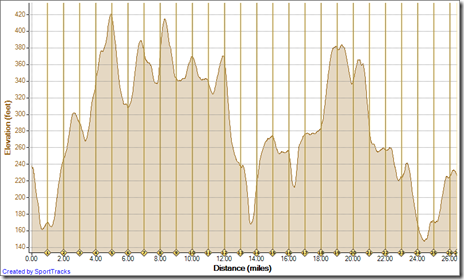

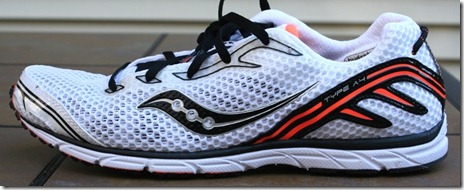
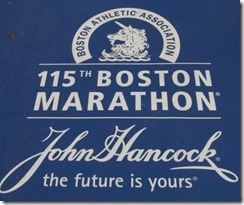


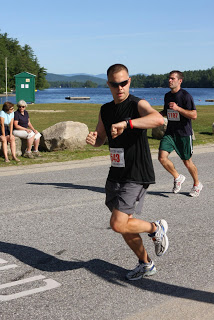














Great report Pete! Congratulations!
I heard in your Disney Marathon Podcast that you delayed gel consumption after mile 8. Do you advise this? I am running RnR SA on Sunday and need a gel cumsumption strategy.
I have been using the strategy of sipping from my watered down gel
flask every mile or two from the start for each of the past two
marathons and it has worked well. I think perhaps a bigger issue that
I did use at Disney is to be done eating breakfast about 2 hours
before the race, and then to have nothing until just before the race
begins. I have kept this approach up. It’s so hard to know what is
right and wrong when it comes to fueling, but the fact that I haven’t
hit the wall recently has me encouraged.
Pete
On Thursday, November 11, 2010, Disqus
Thanks for the report! I’ve been looking forward to it all week. Good work, Pacer Pete.
One of these days I need to run Manchester. Going to be tough fitting it in: it’s only a week after the Conway 1/2! ;)
Thanks Dan! I think may be done with the Manchester full, it’s just a
really tough course. Thinking about going back for just the half next
year.
Pete
On Thursday, November 11, 2010, Disqus
Hi, Pete. Excellent post as usual! Let me ask you few questions. First, you say you think a marathon deserves a more “forgiving shoe”. Therefore, I understand you are not considering running a marathon in a more minimalist shoe ever, or, at least, in the short-mid term. Is it correct? I ask this because, you know, I am more or less where you were some time ago, increasing my training distance on a weekly basis and I am using a very minimal shoe with great results (plantar fasciitis disappeared and so on). I am preparing for a half marathon and then plan to run a marathon. So you think that maybe a good approach is to use a minimalist shoe when training to strength your legs and improve running form and then use a more “forgiving” shoe at the day of the race? Is that your plan going forward?
Best regards,
Sergio (from Brazil)
Sergio – it’s hard and this question probably deserves it’s own post.
I guess all I can say is that on the day I ran Manchester, I think
more shoe would have been warranted. Had I been training regularly in
the A4’s, and had this been my only marathon this Fall, perhaps things
would be different. I just know that given my level of fatigue, the
Kinvara would have been a better choice. Still a relatively minimal
shoe, but it has a good deal more cushion than the A4. I’d tell you
that if you are training regularly in a very minimal shoe and it’s
working for you, stick with it, particularly if you are wearing it
with success on your long runs. At least for my body, I seem to do
better when I mix things up, but we are all different and have to find
our own formula.
Pete
On Thursday, November 11, 2010, Disqus
OK, Pete, thanks. Understand your point. What I am getting is that makes sense to use the minimal shoe on a particular race IF I am comfortable enough with distance and planned pace that makes me sure I will not land on my heels anytime during the full race. Otherwise, maybe it is more prudent to use a protective shoe. Anyway, fully agree with you that it is a good idea to practice using different shoes and pavements. It allows you the flexibility to change the approach depending on the race and also reduces the risk of stress related injuries.
I would agree with probably everything here except maybe the statement
“anytime during the full race” with respect to the marathon. Holding form in
the final few miles is always going to be a challenge, so you can probably
get away with slipping for a few mile in a minimal shoe – I have seen Vibram
runners slamming their heels coming into the finish line. You just want to
be sure that you can handle most of the race in good shape.
Pete
Ok, understood. I was probably being naive by thinking that it is possible for an amateur to run a full marathon in a perfect form. That is the lack of experience. Your approach seems more reasonable. Thanks again.
Sergio (Brazil)
Don’t get me wrong, I think running a good form marathon can be done, it
just depends on how well you have trained and how hard you push during the
race. When I have hit the wall, my form is shot completely, and I fear even
thinking about how I looked! The marathon is always a learning experience,
no matter how many you have run.
Pete
Hey Pete- I was wondering how those A4’s would be for a marathon – I’ve had a few patients in the clinic wearing them recently and am thinking of getting a pair. Choosing a racing flat for marathons has always beena bit tough for me. I tried the Brooks Ghost Racer last year for Boston in an attempt to not go too thin, and had problems that way too. Might have to look at the Kinvara now since you had such a good experience with them.
The problem I have is that this was by no means a controlled comparison. Ran
Manchester on hills and tired legs, so that played a big role I’m sure, but
I think that the Kinvara is probably the better choice for a marathon. If it
were 13.1 or less, the choice becomes much more difficult. The main
differences between the two are the lower, firmer sole in the A4, and the
narrower fit of the A4. A4 is also about an ounce lighter.
Pete
Congratulations on another great marathon! I’m impressed that you managed to hold so constant a pace despite significant elevation grade changes throughout the event. I suppose that assisting a marathon pace group leader that you’re required to do so throughout, versus speeding-up somewhat on the downhills and slowing down a bit on the uphills? My only other hilly paced marathon was in Austin, TX, and similar to your strategy the pace leaders maintained a very constant pace (which I found more natural to depart from a bit via running ahead of them on the downhills, but falling back on the uphills). It’s also great that you’ve now got your fueling and pre-race nutrition figured out.
Mark,
We did speed up on the downs and slow on the ups, but the hills were so
frequent that it evened out the pace overall I think. The lead pacer was
following a steady effort rather than steady pace plan.
Pete
That elevation profile is awesome! Well done, Pete! I had no doubt that you’d run a great race. And, I’m glad you had the opportunity to experiment with your footwear. I was excited about your rather daring attempt to wear the A4 after having only run in it a couple of times before. Glad you didn’t sustain any horrible injuries.
Oh, and be sure to post that finish line picture if you feel so inclined. It sounds like it’ll be a good one!
Twitter just sent me to your blog. Had not seen before :) I too ran the Manchester last week and feel like I could just lift your summary – and switch feet – right foot. I failed to memorize the elevation profile and way underestimated the back side – mismanaged my pace then my gait. Like you, I switched to the midfoot last year and have been doing several races each year. Manchester was my second race in a month…
Great summary. Thanks for sharing…
Thanks for the comment – Manchester is a killer course. May need a break
from it for a few years :)
Pete